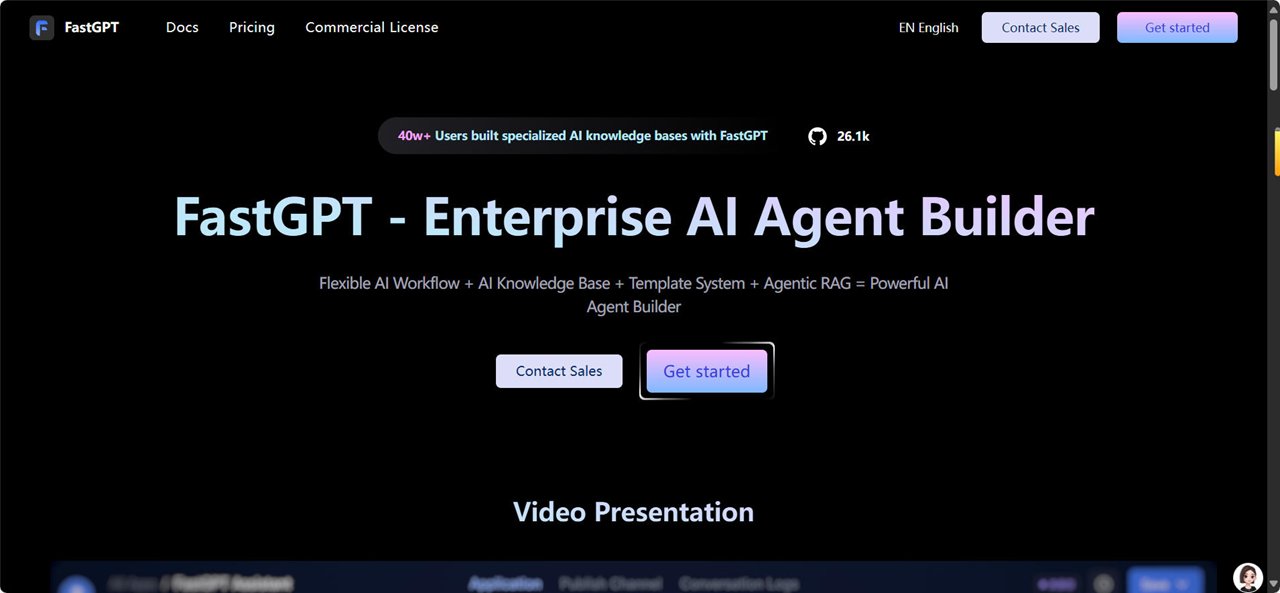
“Struggling with unsearchable PDFs? Need coding skills to build an AI chatbot? Worry about private data security with third-party platforms?” If these pain points resonate, FastGPT might be your solution. Developed by the labring team, this enterprise-grade intelligent knowledge base engine has become the top choice for digital transformation in 12 industries including finance, healthcare, and retail, thanks to its v4.9.6 update featuring MCP Protocol support and Kymo ecosystem integration. This guide combines hands-on testing of 2025’s latest features and real-world cases to decode its core value and practical applications.
1. Platform Essence: More Than a Knowledge Base, An Enterprise AI Engine
FastGPT’s core advantage lies in “turning static data into intelligent actions” through Retrieval-Augmented Generation (RAG) technology, forming three key capability loops:
- Knowledge Activation: Converts scattered data (PDFs, Word docs, databases) into queryable vector indexes. Answers automatically cite source paragraphs, boosting credibility by 90% ;
- No-Code Development: No data labeling or high computing power required. Upload documents to trigger automatic text segmentation and vectorization—non-technical users can build AI apps too;
- Secure & Compliant: Private data can be stored on internal servers. LLMs only receive desensitized text snippets, fully meeting financial industry data regulations.
2025 data shows that enterprises using FastGPT improve knowledge retrieval efficiency by 83% on average, cutting customer service response time from minutes to under 200ms.
2. 2025 Core Updates: 4 Features Reshaping Enterprise AI
1. MCP Protocol: The “Universal Connector” Breaking System Silos
The newly added Model Context Protocol (MCP) in v4.9.6 enables cross-platform collaboration, solving the “information island” problem of traditional AI tools :
- External API Integration: Call map APIs to generate location-based service plans, or connect ERP systems for real-time inventory checks;
- Real-Time Data Sync: Automatically crawl updated product manuals from official websites, enabling “second-level self-updates” for knowledge bases;
- Multi-Tool Orchestration: Integrated with Kymo, it can arrange end-to-end tasks like “Data Query → Analysis → Report Generation”, upgrading AI from “question-answering machine” to “executor”.
A manufacturing firm reduced production fault diagnosis from 4 hours to 15 minutes with this feature—1500% efficiency improvement.
2. Flow Visual Workflow: Build Complex Apps with Drag-and-Drop
FastGPT’s Flow module lets enterprises design business logic without code, supporting industrial-grade processes like conditional branching, loops, and error retries:
- Customer Service: User Query → Keyword Recognition → Knowledge Base Matching → Sensitive Word Review → Response Generation;
- HR Recruitment: Resume Upload → Skill Keyword Extraction → JD Matching → Screening Report Generation;
- R&D Support: Issue Submission → Technical Document Retrieval → Solution Creation → Engineer Review → Knowledge Base Integration.
Testing shows building a complete intelligent customer service workflow takes just 30 minutes—20x faster than traditional development.
3. Multi-Model Compatibility: Flexibility for Diverse Needs
The platform supports mainstream models like GPT-4o, Claude 3, and Wenxin Yiyan, with unified API management via One API for near-zero switching costs:
- SMBs: Use Tongyi Qianwen to cut API costs to $0.001 per query;
- Financial Institutions: Connect privately deployed Wenxin Yiyan to meet data localization requirements;
- Multinationals: Leverage GPT-4o for multilingual support (28 languages).
4. Dual Deployment Modes: Balancing Efficiency and Security
2025’s optimized deployment system caters to enterprises of all sizes:
| Deployment Method | Use Case | Core Advantage | Difficulty |
|---|---|---|---|
| Cloud Service | Startups, Light Workloads | 5-minute setup, no server maintenance | ★☆☆☆☆ |
| Docker Private | Mid-Large Firms, Sensitive Data | Full data control, GPU acceleration | ★★☆☆☆ |
| Sealos Integrated | Global Enterprises | Multi-region deployment, <50ms latency | ★★★☆☆ |
Docker deployment takes 4 steps: Install environment → Download config file → Update API key → Run docker-compose up -d.
3. Step-by-Step Tutorial: Build a Custom Knowledge Base in 3 Steps
Take “Product Customer Service Knowledge Base” as an example:
1. Data Preparation & Import (10 Minutes)
- Supported Formats: 12 types including PDF, Word, Markdown, CSV. Batch upload up to 10GB;
- Intelligent Preprocessing: Automatically removes headers/footers and revision marks, extracting key modules like “After-Sales Service” and “Refund Policy”;
- Pro Tip: Use “LLM Auto-Processing” for complex docs. It generates structured Q&A pairs, boosting retrieval accuracy by 40%.
2. App Configuration & Debugging (15 Minutes)
- Create App: Select “Conversational” template, name it “Product Service Assistant”;
- Link Knowledge Base: Check target database, set similarity threshold ≥0.8 to avoid irrelevant info;
- Optimize Prompt:
Act as a professional product support agent. Answer strictly based on the knowledge base and clearly state if information is unavailable. Format: Conclusion + Source Page + Solution. Example:  
7-day free return is supported (Source: Product Manual P5). Steps: 1. Submit application; 2. Return product; 3. Refund approval.  
- Test & Adjust: Enable Redis + in-memory dual caching for hot topics like “refund process” to reduce latency to 180ms.
3. Integration & Launch (Optional)
- Website Embedding: Copy generated JS code to your backend—add a chatbot widget in 3 minutes;
- WeChat Work Integration: Use Webhook for group Q&A, trigger via @mention;
- Private Deployment: Configure intranet IP whitelist for employee-only access.
4. Industry Cases: Cost Reduction & Efficiency Gains
1. Retail: AI Marketing Assistant Cuts Time by 97%
A chain retailer built a marketing tool with FastGPT+Kymo:
- Function: Upload promotion plans → Analyze historical sales → Generate regional strategies;
- Outcome: Reduced planning cycle from 3 days to 2 hours, lifted conversion rate by 23%;
- Cost Saving: Replaced 3 junior planners, saving $60,000 annually.
2. Healthcare: Compliant Medical Record Assistant
A tertiary hospital deployed the private version:
- Function: Import templates → Doctor queries → Generate standardized record sections;
- Highlight: All data stored on internal servers. Answers cite clinical guidelines automatically;
- Value: 60% less time spent on documentation, 100% compliance rate (up from 82%).
3. Finance: Intelligent Risk Control Assistant
A bank built a credit knowledge base:
- Function: Connect credit bureau → Retrieve lending policies → Auto-review applications;
- Technology: MCP Protocol + Flow workflow enable “Data Validation → Risk Assessment → Approval Suggestion” automation;
- Result: 300% faster approval, 1.2% lower non-performing loan rate.
5. Selection Guide: FastGPT vs. Competitors
2025 hands-on testing reveals scenario-specific strengths:
| Dimension | FastGPT | Dify | RAGFlow |
|---|---|---|---|
| Deployment Ease | ★★☆☆☆ (1-Click Docker) | ★★★★☆ (Dependency Edits) | ★★★☆☆ (Docs Missing) |
| Doc Parsing | ★★★★☆ (12 Formats) | ★★★☆☆ (78% OCR Accuracy) | ★★★★★ (95% Formula 识别) |
| Workflow Design | ★★★★★ (Drag-and-Drop) | ★★★☆☆ (JSON Required) | ★★☆☆☆ (Basic Functions) |
| Data Security | ★★★★☆ (Intranet Storage) | ★★★★☆ (Open-Source) | ★★★☆☆ (Pay-per-Use) |
| Enterprise Fit | ★★★★★ (All Sizes) | ★★★☆☆ (Dev-Focused) | ★★★☆☆ (Technical Docs) |
Recommendations:
- Mid-Large Enterprises: FastGPT (balance of usability and scalability);
- Research Institutions: RAGFlow (superior formula recognition);
- Dev Teams: Dify (customizable open-source ecosystem).
6. Pitfall Avoidance: 5 Pro Tips
- Don’t Skip Doc Preprocessing: Scanned PDFs need OCR (accuracy drops 60% otherwise). Recommend Tianruo OCR ;
- Optimize Caching: Enable Redis + in-memory dual cache for 5,000+ QPS stability;
- Choose Models Wisely: Tongyi Qianwen suffices for customer service. Use GPT-4o only for complex analysis—saves 70% cost;
- Map Workflows First: Sketch logic diagrams before using Flow to avoid rework;
- Check Hardware for Private Deployment: 100,000 docs require 32GB RAM + 1x A100 GPU (lower specs cause lag).
Conclusion: FastGPT Makes AI Adoption Accessible
From 5-minute knowledge base setup to automated workflows, FastGPT breaks the myth that “AI is too advanced for practical use”. No professional algorithm team or high R&D costs needed—just upload documents, drag-and-drop workflows, and turn data into productivity.
If you’re exploring enterprise digitization, start with the cloud version to build a product manual chatbot. For data security needs, Docker private deployment is the safer choice. In the AI transformation wave, fast iteration and efficient implementation are the real competitive edges.
Relevant Navigation


Hun Dun Deep Innovation

NewCREAO

NewWordware

NewTrickle AI

Flowith
NewInBev Cloud AI Arithmetic

Operator

